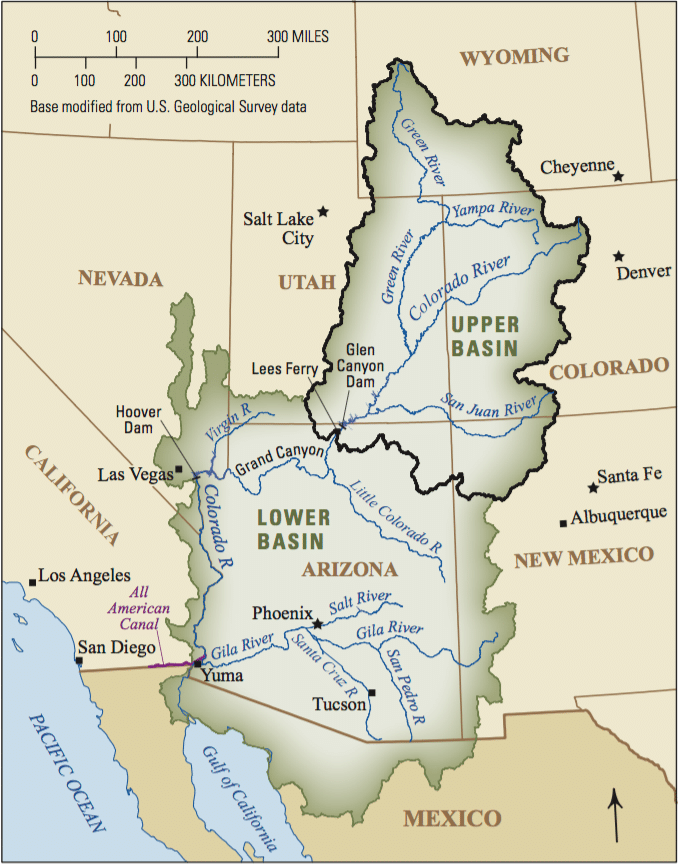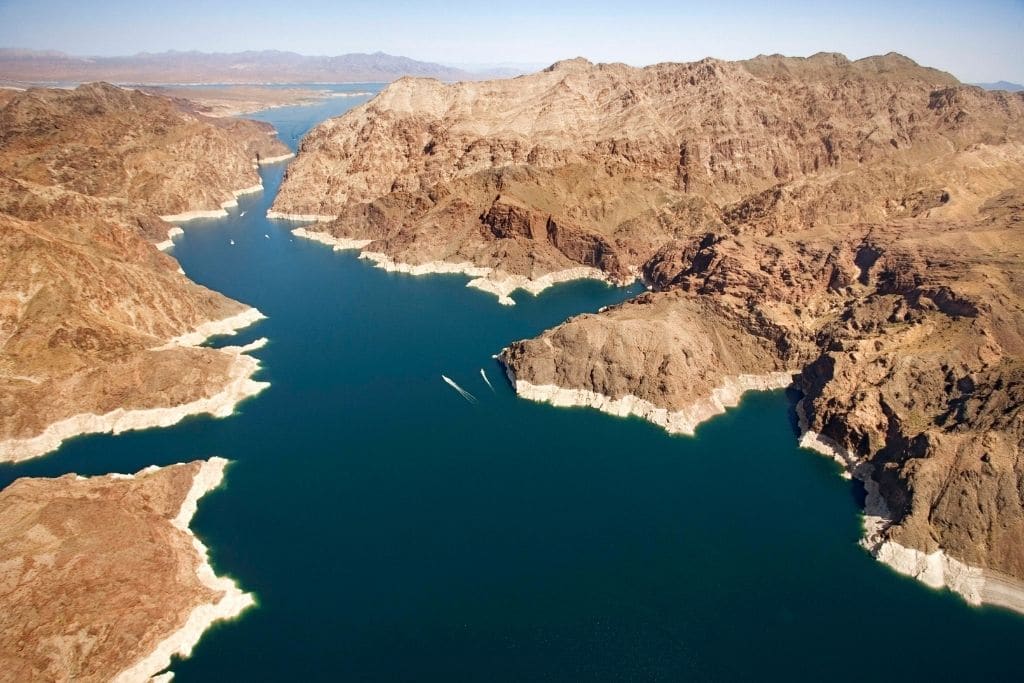The Colorado River Basin is one of the primary sources of water supply in the American Southwest. Comprising parts of seven US and Mexican states and 29 federally recognised tribes, it currently delivers water to 40 million people and has supported the region’s economic growth since the early 1900s. Lake Mead, formed by the famed Hoover Dam along the Colorado River, is the largest reservoir by volume in the United States. The reservoir is significant because more than half of the population in the Colorado River Basin relies on it. We reflect on the growing threat of Colorado River water shortage, as well as in Lake Mead, and the impacts this could on the environment and millions of people that depend on it.
—
Formal Water Shortage Declared for Lake Mead
According to the US Bureau of Reclamation, Lake Mead is experiencing record-low water levels, primarily due to the historic, 20-year long drought conditions caused by a combination of natural and anthropogenic activities. These record lows prompted the first-ever Tier 1 Water Shortage declaration for the reservoir, which has been in effect since early 2022. Water users in Arizona, Nevada, and Mexico will be required to reduce their water consumption and look for ways to conserve water during the declaration.

Impacts of Lake Mead Water Shortage on the Entire Colorado River Basin
The water shortage is expected to have cascading influence beyond Lake Mead and could potentially disrupt political agreements and management guidelines that have governed the Colorado River Basin since the early 1900s. States that rely on the basin signed the Colorado River Compact in 1922, which sets overarching goals in the upper and lower basins.
One of those goals requires a certain amount of water to remain in the upper basin so that it reaches the lower basin. If drought conditions continue, the agreement could be broken. Reporter Michael Saka advises that the ongoing drought “could trigger a formal water delivery shortage and what’s known as a ‘compact call’ for the first time. The result could mean upper basin states, including Colorado, are forced to cut off some water users to make sure there is enough water in the river to flow downstream.”
The current Colorado River water shortage declaration has hit Arizona the hardest. Nearly one fifth of Arizona’s water supply will be cut off, based on the 2007 Colorado River Interim Guidelines for Lower Basin shortages and drought contingency plans for the upper and lower basins.
According to the 2007 guidelines, “conflict over water is unsurprising and anticipated [as] declining reservoir levels in the basin [lead] to interstate and inter-basin tensions.”
Arizona farmers will be among the first to be affected by the federal water cuts, requiring them to take conservation measures including fallowing land, meaning that a portion of cropland cannot be planted for an entire season. Municipal water users are currently spared from the shortage but could experience extreme effects beyond reduced water supply in the near future.
The water level in Lake Mead is around 1,065 feet and the current management guidelines only address water shortages down to 1,025 feet. If water levels continue to decline in the coming years, water shortages will affect more than just the water supply. Indeed, if the reservoir drops below 895 feet, it is considered a “dead pool” condition, which will jeopardise the Hoover Dam’s ability to provide electricity – leaving nearly 1.3 million people in Arizona, California, and Nevada without power.
You might also like: US Drought: What are the Causes, Effects and Solutions
Causes of Drought: Dams, Reservoirs, and the Lack of Emphasis on the Environment
The American Southwest is a region known for its stunning geology, deserts, mountains, and panoramic vistas – not the abundance of water. It is dominated by an arid climate, which inherently creates water supply issues.
Traditional management of the water supply has largely included the creation of dams, and their subsequent reservoirs. These innovations were necessary to provide water to the growing population in the West. However, their implementation was catalysed by development pressures during the 20th century and as a result, many environmental aspects were brushed aside.
The reservoirs created by dams increase the water surface area. This increase in surface area contributes to increased evaporation rates. When coupled with the ongoing drought conditions and aridity of the West, alongside increased aridity expected to be produced by climate change, it is leaving these reservoirs incredibly vulnerable.
Large scale farms in the West grow a variety of water intensive crops, including corn, wheat, and soybeans, which rely on spray irrigation from these reservoirs. This type of irrigation exacerbates water losses, primarily through inefficient transportation methods.
Dams also divert downstream flows, trap sediment and nutrients, and impair water quality – all of which threaten the riparian habitat of the Colorado River that is necessary for a stable ecosystem. The Colorado River flows through 11 national parks and monuments, including the Grand Canyon and Zion National Park, all of which host a variety of unique ecosystems and support a robust tourism industry.
“Human needs have historically taken precedence over environmental concerns when managing water and other natural resources. Natural organisms do not follow political boundaries, so laws and other policy actions are not always aligned with the specific needs of plants, animals, and water,” says Natalie Triedman of Colorado College.
The environmental aspects of dams and reservoirs in the Colorado River Basin have been largely ignored. Indeed, the Colorado River Compact is a clear example of this, which appropriates water for human use only. But humans are not the only ones who use the water and rely on it for survival. Amidst a growing societal concern for the environment, federal and state governments will be facing pressure to consider solutions beyond traditional water management.
Proposed Solutions and Future Outlook
The Tier 1 Water Shortage in effect for Lake Mead is considered a critical situation. Lake Powell, created by the Glen Canyon Dam, is also experiencing record low water levels. But Lake Powell is located upstream of Lake Mead and the Hoover Dam – meaning it receives a much larger percentage of the precipitation that subsequently feeds the entire Colorado River system.
Both dams will be required to limit the quantity of water released to downstream users, but as the Bureau of Reclamation emphasises, the first-ever Lake Mead water shortage declaration “demonstrates the severity of the drought and [Lake Mead’s] low reservoir conditions.”
Not surprisingly, more dams and diversions have been explored as potential long-term solutions. The Arizona State Legislature has even urged Congress to investigate the possibility of harvesting Mississippi River floodwaters to provide an additional source of water.
Increased reporting of water wastes, following seasonal water restrictions, and replacing unused grass with water smart landscapes are among the most widely utilised conservation measures. Indeed, Nevada Governor Steve Sisolak signed Assembly Bill 356 in 2021, which required the replacement of unused grass landscapes, or those landscapes that are covered with turf grass for solely aesthetic purposes, by the end of 2026.
“By upgrading unused grass to water-smart landscaping, we can save more than 9.5 billion gallons of water annually, which represents about 10 percent of our total annual water supply from the Colorado River at Lake Mead,” said John Entsminger, General Manager of the Southern Nevada Water Authority.
This policy effort shows a commitment to work with the natural environment of the American Southwest to improve water savings, rather than implementing the same infrastructure that is the subject of these drought conditions in the first place. Expanding municipal water conservation through this improved landscaping is indeed a great first step, but municipalities, industries, and agriculture alike will need to reevaluate their management practices to ensure continued water supply. If water demand continues to outpace water supply, this will lead to something called “water bankruptcy.”
Water bankruptcy, in essence, promises too much water without enough supply. Solutions aimed at increasing water storage capacity, such as harvesting water from the Mississippi and creating more dams, disregard demand and only focus on increasing supply.
Agriculture in particular is one of the greatest demands placed on the entire Colorado River System – consuming nearly 80% of the basin’s water. Water policy efforts must acknowledge the connection between agriculture and water use in the West to ensure proper management.
Reporter Saul Elbein tells us that “drought in the [US] West has been deepening for two decades, with no end in sight. Unfortunately for farmers, water use policies established in the early 20th century (a time of more plentiful rainfall), have left regulators struggling with their hands tied as they confront climate change challenges — especially intensifying drought.”
The March 2022 drought outlook indicates that the situation is not improving. As the region continues to tackle the Colorado River Basin water shortage issue, new policy efforts need to consider alternative strategies that address the impact of water use on agriculture and the natural environment, rather than struggling to meet unsustainable demands.
You might also like: How Water Conflicts as a Result of Climate Change Will Shape Our World

















